Easy Way to Find Chi Square Test
Observed Variables: Definition
Contents
Definitions
- What is a Chi Square Examination?
- What is a Chi-Foursquare Statistic?
- Chi Foursquare P-Values.
- The Chi-Square Distribution & Chi Distribution
Calculations:
- How to Summate a Chi-Square Statistic:
- By Hand (with video)
- SPSS Instructions.
- How To Examination a Chi Square Hypothesis (with video)
See also:
- Chi-foursquare exam for normality.
What is a Chi Foursquare Exam?
Picket the video for an overview of the tests:
Can't see the video? Click here.
In that location are two types of chi-square tests. Both use the chi-square statistic and distribution for unlike purposes:
- A chi-square goodness of fit test determines if sample information matches a population. For more details on this type, come across: Goodness of Fit Examination.
- A chi-foursquare examination for independence compares two variables in a contingency table to run across if they are related. In a more general sense, it tests to see whether distributions of categorical variables differ from each another.
Back to Top
What is a Chi-Square Statistic?
The formula for the chi-square statistic used in the chi square test is:
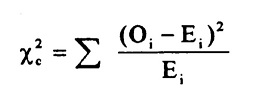
The chi-foursquare formula.
The subscript "c" is the degrees of freedom. "O" is your observed value and East is your expected value. It's very rare that you lot'll want to really use this formula to find a critical chi-square value by hand. The summation symbol ways that you'll have to perform a calculation for every single information item in your data set. As you can probably imagine, the calculations can get very, very, lengthy and tedious. Instead, you'll probably want to use engineering science:
- Chi Square Test in SPSS.
- Chi Square P-Value in Excel.
A chi-square statistic is one style to testify a relationship between 2 categorical variables. In statistics, there are two types of variables: numerical (countable) variables and not-numerical (chiselled) variables. The chi-squared statistic is a single number that tells you how much difference exists between your observed counts and the counts yous would expect if there were no relationship at all in the population.
There are a few variations on the chi-square statistic. Which 1 you use depends upon how you collected the data and which hypothesis is beingness tested. Even so, all of the variations use the same idea, which is that you are comparison your expected values with the values y'all really collect. One of the well-nigh mutual forms can be used for contingency tables:

Where O is the observed value, E is the expected value and "i" is the "ith" position in the contingency tabular array.
A low value for chi-square means there is a high correlation betwixt your 2 sets of information. In theory, if your observed and expected values were equal ("no departure") then chi-square would be zero — an result that is unlikely to happen in real life. Deciding whether a chi-square exam statistic is large enough to bespeak a statistically meaning difference isn't as easy it seems. It would be nice if we could say a chi-square examination statistic >10 means a deviation, merely unfortunately that isn't the example.
You could take your calculated chi-foursquare value and compare information technology to a critical value from a chi-square tabular array. If the chi-square value is more the critical value, then in that location is a meaning difference.
You could as well use a p-value. First state the cipher hypothesis and the alternate hypothesis. And so generate a chi-foursquare curve for your results forth with a p-value (See: Calculate a chi-foursquare p-value Excel). Minor p-values (under 5%) usually bespeak that a difference is significant (or "minor plenty").
Tip: The Chi-square statistic can only be used on numbers. They tin't exist used for percentages, proportions, means or similar statistical values. For example, if you have x per centum of 200 people, y'all would need to convert that to a number (20) earlier you can run a test statistic.
Dorsum to Top
Chi Square P-Values.
A chi foursquare exam will give you a p-value. The p-value will tell you if your exam results are significant or not. In order to perform a chi square exam and get the p-value, you lot demand two pieces of information:
- Degrees of freedom. That'southward just the number of categories minus ane.
- The alpha level(α). This is chosen by you, or the researcher. The usual blastoff level is 0.05 (5%), but you could as well take other levels similar 0.01 or 0.10.
In uncomplicated statistics or AP statistics, both the degrees of freedom(df) and the alpha level are usually given to you lot in a question. You don't normally have to effigy out what they are. You lot may have to figure out the df yourself, but it's pretty unproblematic: count the categories and subtract i.
Degrees of freedom are placed equally a subscript after the chi-foursquare (Χtwo) symbol. For example, the following chi square shows 6 df:
Χ2 6.
And this chi square shows iv df:
Χ2 4.
Back to Peak
The Chi-Square Distribution
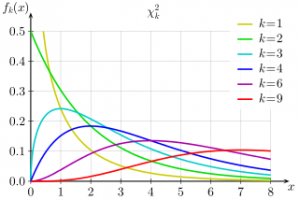
Past Geek3|Wikimedia Commons GFDL
The chi-square distribution (also chosen the chi-squared distribution) is a special case of the gamma distribution; A chi square distribution with due north degrees of freedom is equal to a gamma distribution with a = n / ii and b = 0.5 (or β = two).
Allow'south say you have a random sample taken from a normal distribution. The chi foursquare distribution is the distribution of the sum of these random samples squared . The degrees of liberty (k) are equal to the number of samples being summed. For example, if you accept taken 10 samples from the normal distribution, then df = 10. The degrees of freedom in a chi foursquare distribution is also its mean. In this case, the hateful of this particular distribution will exist 10. Chi square distributions are always right skewed. Notwithstanding, the greater the degrees of freedom, the more the chi square distribution looks similar a normal distribution.
A chi-bar-squared distribution is a mixture of chi-square distributions, mixed over their degrees of freedom. Yous'll oftentimes observe them when testing a hypothesis with an inequality [1].
Uses
The chi-squared distribution has many uses in statistics, including:
- Conviction interval interpretation for a population standard divergence of a normal distribution from a sample standard deviation [ii].
- Independence of two criteria of classification of qualitative variables.
- Relationships betwixt chiselled variables (contingency tables).
- Sample variance study when the underlying distribution is normal.
- Tests of deviations of differences between expected and observed frequencies (one-fashion tables).
- The chi-foursquare test (a goodness of fit test).
Chi Distribution
A similar distribution is the chi distribution [3]. This distribution describes the square root of a variable distributed according to a chi-square distribution.; with df = n > 0 degrees of freedom has a probability density function of:
f(x) = 2(1-n/2) ten(n-1) east(-(x2)/2) / Γ(n/2)
Back to Top
How to Calculate a Chi Square Statistic
A chi-square statistic is used for testing hypotheses. Watch this video, How to summate a chi square.
Chi Square Statistic (by manus)
Can't see the video? Click hither.

The chi-foursquare formula.
The chi-square formula is a hard formula to bargain with. That'south mostly because you're expected to add a large corporeality of numbers. The easiest manner to solve the formula is by making a table.
Example question: 256 visual artists were surveyed to notice out their zodiac sign. The results were: Aries (29), Taurus (24), Gemini (22), Cancer (19), Leo (21), Virgo (eighteen), Libra (19), Scorpio (xx), Sagittarius (23), Capricorn (18), Aquarius (20), Pisces (23). Test the hypothesis that zodiac signs are evenly distributed beyond visual artists.
Step i: Make a table with columns for "Categories," "Observed," "Expected," "Residual (Obs-Exp)", "(Obs-Exp)2" and "Component (Obs-Exp)ii / Exp." Don't worry what these hateful right at present; We'll cover that in the post-obit steps.
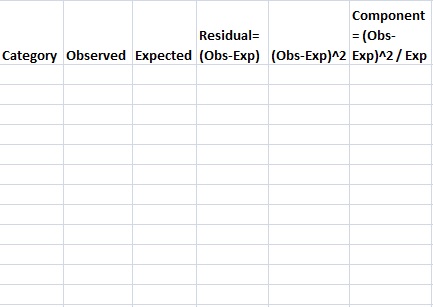
Footstep 2: Make full in your categories. Categories should be given to yous in the question. In that location are 12 zodiac signs, so:
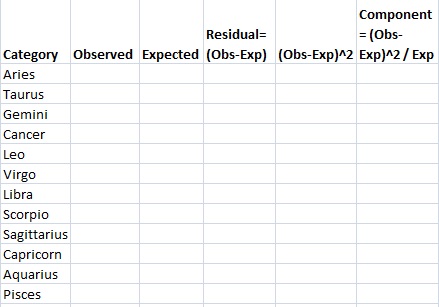
Pace 3: Write your counts. Counts are the number of each items in each category in cavalcade 2. You're given the counts in the question:
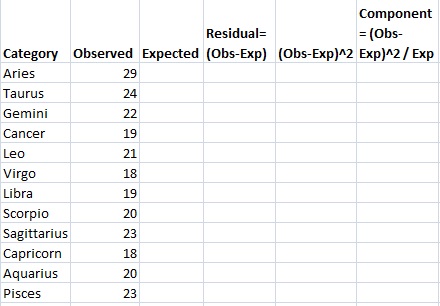
Step 4: Summate your expected value for column three. In this question, we would expect the 12 zodiac signs to be evenly distributed for all 256 people, so 256/12=21.333. Write this in cavalcade 3.
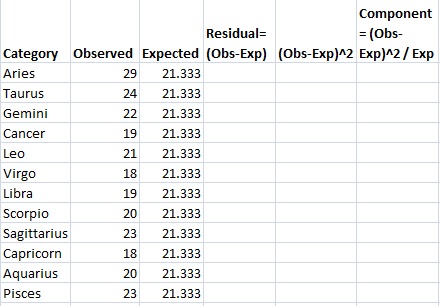
Step 5: Decrease the expected value (Step 4) from the Observed value (Stride 3) and place the result in the "Residual" column. For instance, the first row is Aries: 29-21.333=7.667.
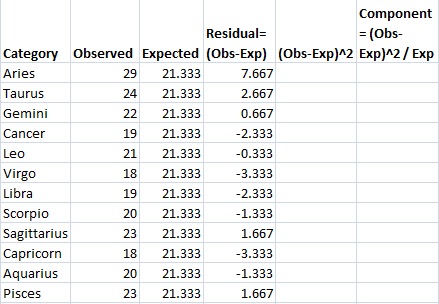
Pace 6: Square your results from Step 5 and place the amounts in the (Obs-Exp)2 column.
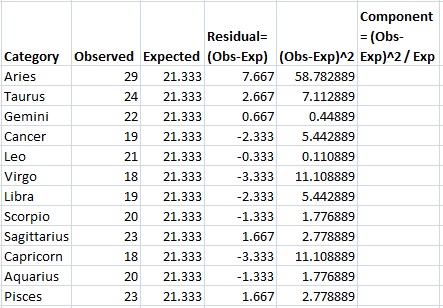
Step 7: Divide the amounts in Stride 6 past the expected value (Step four) and place those results in the last column.
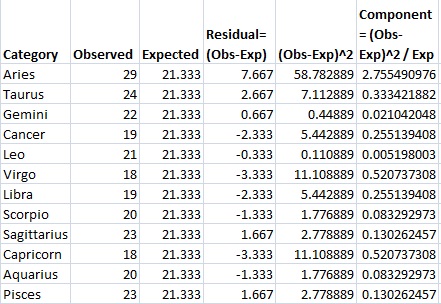
Step eight: Add up (sum) all the values in the last column.
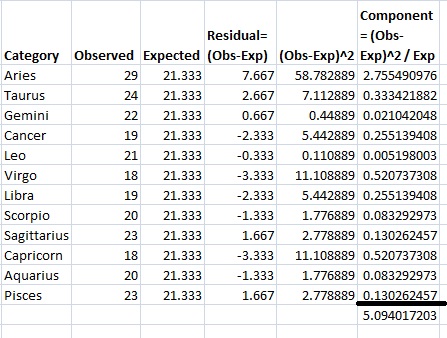
This is the chi-square statistic: five.094.
Like the caption? Cheque out the Practically Cheating Statistics Handbook, which has hundreds more step-by-step explanations, but like this 1!
Back to Pinnacle
SPSS Instructions.
You'll find the chi foursquare examination in SPSS under "Crosstabs".
Instance trouble: Run a chi foursquare examination in SPSS.
Note: In order to run a chi-square test in SPSS you should already take written a hypothesis statement. See: How to state the null hypothesis.
Watch the video for the steps:
How to run a Chi Square Examination in SPSS
Can't come across the video? Click hither.
Pace 1: Click "Analyze," so click "Descriptive Statistics," then click "Crosstabs."
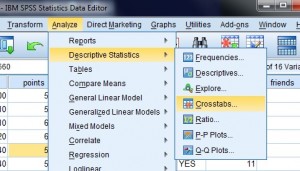
Chi square in SPSS is found in the Crosstabs control.
Step 2: Click the "Statistics" push button. The statistics button is to the right of the Crosstabs window. A new popular up window volition appear.
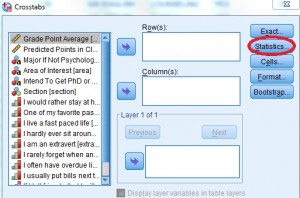
Step 3: Click "Chi Square" to place a check in the box and then click "Continue" to return to the Crosstabs window.
Stride 4: Select the variables you lot desire to run (in other words, choose ii variables that you want to compare using the chi square examination). Click one variable in the left window and then click the arrow at the height to motility the variable into "Row(due south)." Repeat to add a second variable to the "Column(s)" window.
Pace 5: Click "cells" so bank check "Rows" and "Columns". Click "Continue."
Step 6: Click "OK" to run the Chi Square Examination. The Chi Square tests will be returned at the bottom of the output canvass in the "Chi Square Tests" box.
Step 7: Compare the p-value returned in the chi-foursquare area (listed in the Asymp Sig column) to your chosen alpha level.
Back to Top
Cheque out our YouTube aqueduct for more help with stats. Find dozens of videos on basic stats principles plus how to calculate stats using Microsoft Excel.
How To Test a Chi Square Hypothesis (Exam for Independence)
Watch the video for how to test a hypothesis with chi-square using the p-value method:
Chi-Square Exam (P-Value Method)
Can't run into the video? Click here.
A chi-square test for independence shows how categorical variables are related. There are a few variations on the statistic; which one y'all use depends upon how you collected the data. It besides depends on how your hypothesis is worded. All of the variations utilise the same thought; you are comparison the values you expect to go (expected values) with the values you actually collect (observed values). One of the most mutual forms tin exist used in a contingency tabular array.
The chi foursquare hypothesis exam is appropriate if you accept:
- Discrete outcomes (categorical.)
- Dichotomous variables.
- Ordinal variables.
For case, you could take a clinical trial with blood carbohydrate outcomes of hypoglycemic, normoglycemic, or hyperglycemic.
Exam a Chi Square Hypothesis: Steps
Sample question: Test the chi-square hypothesis with the post-obit characteristics:
- xi Degrees of Freedom
- Chi square examination statistic of 5.094
Note: Degrees of liberty equals the number of categories minus i.
Step one: Take the chi-foursquare statistic. Find the p-value in the chi-square table. If you are unfamiliar with chi-foursquare tables, the chi foursquare table link also includes a short video on how to read the tabular array. The closest value for df=eleven and 5.094 is betwixt .900 and .950.
Note: The chi square table doesn't offer exact values for every unmarried possibility. If you use a calculator, you can get an verbal value. The exact p value is 0.9265.
Pace 2: Employ the p-value you constitute in Step one. Decide whether to support or pass up the null hypothesis. In general, pocket-sized p-values (i% to 5%) would cause you lot to reject the null hypothesis. This very large p-value (92.65%) ways that the zero hypothesis should non be rejected.
Like the explanation? Check out the Practically Cheating Statistics Handbook, which has hundreds more step-by-step explanations, only like this ane!
Back to Top
Reference
[1] Chi-Bar-Squared. Retrieved March 9, 2022 from:
[2] Johns Hopkins.
[3] Kenney, J. F. and Keeping, E. S. Mathematics of Statistics, Pt. 2, 2nd ed. Princeton, NJ: Van Nostrand, 1951.
---------------------------------------------------------------------------
Need assist with a homework or test question? With Chegg Study, yous can go step-by-step solutions to your questions from an skillful in the field. Your start xxx minutes with a Chegg tutor is free!
Comments? Demand to post a correction? Please post a comment on our Facebook page .
Source: https://www.statisticshowto.com/probability-and-statistics/chi-square/
0 Response to "Easy Way to Find Chi Square Test"
Post a Comment